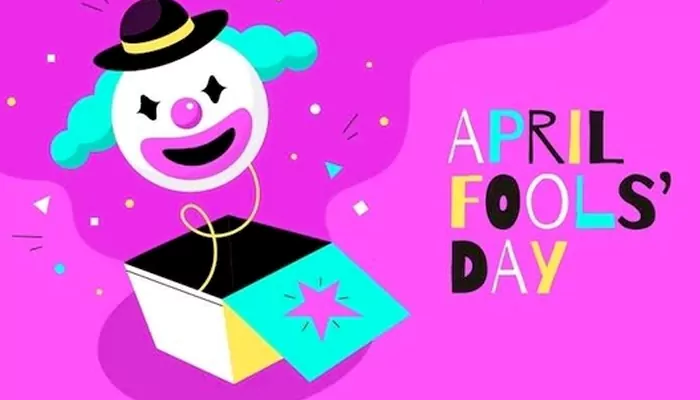
Getting pranked or making a fool of others is what April Fool’s Day is all about—but have you ever wondered about its origin?
We fool others, and sometimes, we get fooled too—it’s part of life. But on April 1, it’s a bit different. On this day, being fooled is a badge of honor and not embarrassing. It feels like a sport—how cleverly can we trick someone, and how smartly can we dodge others’ pranks? Whether it's a harmless joke, a playful hoax, or a surprising twist, April Fool’s Day is all about fun and laughter. And as we share lighthearted moments together, it strengthens our bonds with friends, family, and even colleagues.

But have you ever wondered about where, how, and when did this tradition come from? Was there a particular event that started it all? Or did people just wake up one day and decide to make fools of each other? While no one knows it for sure, there are plenty of theories about the same. So, as we celebrate another April Fool’s Day, let’s take a journey through history and uncover the origins of this fun-filled tradition.
One of the most popular theories points to 16th-century France. Back then, people celebrated New Year’s at the end of March, wrapping up the festivities on April 1st. But in 1582, Pope Gregory XIII introduced the Gregorian calendar, moving New Year’s to January 1st.
Some people, either unaware of the change or refusing to follow it, kept celebrating New Year on April 1st. The rest of society mocked them, sending them on fake errands, playing pranks, and whatnot—a tradition still alive in France today as Poisson d’Avril.
Some historians suggest April Fool’s Day dates back to when France switched from the Julian calendar celebrating the new year on April 1st, to the Gregorian calendar celebrating it on January 1st. 🧵 pic.twitter.com/FtnOWdFwia
— Propel Women (@PropelWomen) April 1, 2024
(Credit: Propel Women)
Sounds convincing, right? The only problem is that April Fools’ Day existed in some parts of Europe even before 1582, meaning this might not be the true origin.
Some believe that Geoffrey Chaucer’s ‘Canterbury Tales’ (1392) may hold a clue. In The Nun’s Priest’s Tale, a trickster fox deceives a vain rooster. The story takes place "Syn March bigan thritty dayes and two"—which, if interpreted a certain way, could mean April 1st.
It’s April Fool’s Day. Geoffrey Chaucer’s The Canterbury Tales (1392) contains the first recorded link between 1st of April and foolishness. pic.twitter.com/qdpyQrOiLl
— Frank McDonough (@FXMC1957) April 1, 2024
(Credit: Frank McDonough)
However, some scholars argue this was a misinterpretation or a scribal error, so whether Chaucer inspired April Fools’ Day is still up for debate.
Long before April Fools' Day, Romans and medieval Europeans loved a good prank.
Hilaria (Ancient Rome): A festival of laughter, disguises, and tricks held at the end of March.
#OTD. In Ancient #Rome November 3rd was a day for merriment and joy called #Hilaria. The festival owed its origin to an Egyptian involving Isis, Osiris and Seth.
— Trimontium Trust (@TrimontiumTrust) November 3, 2023
On this day the Romans used to play practical jokes on each other, as we do on April Fool's Day. pic.twitter.com/6fUrIZb3KS
(Credit: Trimontium Trust)
Feast of Fools (Medieval Europe): A day where people mocked authority figures and switched roles.
In medieval times, The Lord of Misrule turned Christmas festivities upside down and presided over the Feast of Fools. A peasant was chosen to oversee revelry, mock authority, and lead wild celebrations, bringing chaos and laughter to courts and manors alike. #LegendaryWednesday pic.twitter.com/GgQULPRBSC
— Historium Unearthia (@HistoriumU) December 18, 2024
(Credit: Historium Unearthia)
Could these old traditions have evolved into April 1st pranks? Many historians think so!
In 1561, a Flemish poet Eduard de Dene wrote about a nobleman who sent his servant on pointless errands on April 1st. This suggests that pranks on this date were already a thing in parts of Europe. If it was happening then, does that mean it started even earlier? Quite possibly!
Eduard de Dene was a 16th century Flemish poet who often got himself into trouble.
— Signe Maene is on Bluesky, Instagram & elsewhere (@MaeneSigne) April 1, 2020
He also wrote about a nobleman who always sent his servants on silly missions on the 1st of April.
And he published an emblem book about fables and animals.👇🦎#AprilFoolsDay #History pic.twitter.com/cx2tVo9inG
(Credit: Signe Maene is on Bluesky, Instagram & elsewhere)
Different cultures celebrate this day in their own way:
France & Italy: People prank each other and yell “Poisson d’Avril!”
Scotland: The pranking lasts two days! First, sending people on fake errands, then pinning "Kick Me" signs on their backs.
UK & Ireland: Pranks are only allowed before noon—after that, the prankster becomes the fool!
Brazil: Dia da Mentira (Day of Lies) sees newspapers and media outlets join in with fake news stories.
So, where did April Fools’ Day truly begin? We may never know for sure. But one thing is clear: we love a good joke! And it's a reminder to not take life too seriously, to laugh a little, and to enjoy the harmless fun.
(References: